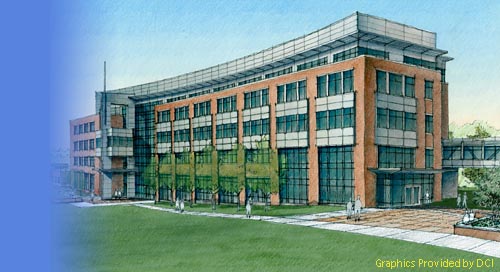Building Statistics
General Building Statistics
Building Name- Health and Human Services Building
Location- Baltimore, Maryland
Building Occupant- Coppin State University
Function- Academic
Size- 150,000 sq. ft.
Levels- 5
Owner – University of Maryland, Baltimore
Client - Coppin State University
CM- Barton Malow Company
Architect- Design Collective Inc.
Engineers- Structural- Hope Furrer Associates
Mechanical/Electrical- RMF Engineering
Civil- Site Resources
Dates of Construction- 1/23/06 – 6/23/08
Project Cost- Project Cost- $48,662, 865
Building Cost- $44,115,980
Delivery Method- CM at Risk- Soft GMP
Architecture
Design and Function:
This project involves the construction of a new academic building for Health and Human Services at Coppin State University. The building is 150,000 gross square feet on a site bordered on the North by North Avenue, the CSX railroad to the West, on the South by Baker Avenue and on the East by a 20’ Alley between Whitmore and Thomas Avenues. Demolition of existing site improvements, row houses and the closure of some roads will be necessary.
The new academic building will consist of a child-care center demonstration suite, lecture halls, meeting rooms and an outpatient health clinic on the ground floor, additional outreach offices, classrooms and labs on the second floor and classrooms, labs, graduate student and faculty offices on the third, fourth and fifth floors. Air-handlinMay 2, 2007cessible by a stair tower. Chillers and boilers will be located in the basement along with electrical equipment, a future South campus telecommunications hub and water service. An overhead connector for pedestrians will join the second floor of the new academic building with a future parking garage. The garage will be constructed on the North side of North Avenue with a link to the Grace Hill Jacobs Building. Additionally, a service road will be constructed along the West and South edges of the site connecting North Avenue with Presbury Street.
The building program provides classroom, research, meeting and office space for the Divisions of Graduate Studies, Nursing, Criminal Justice, Social Work, Applied Psychology and Rehabilitation Counseling, and facilities shared by all of these areas of study. Space for various community outreach and clinical programs that are an integral part of the College and of these programs is provided.
National Model Codes- All codes adopted by the state of Maryland.in 2000.
Zoning- Unclassified
Historical Requirements- None
Building Envelope- Glass Curtain Wall, Brick, Metal Panels & Storefront
Roofing System- Metal Roof, EPDM single ply membrane roofing, hot fluid applied roofing
Building Systems
Structural System
The structural system for the Health and Human Services Building is primarily ASTM A992 Structural Steel with composite metal decking. The metal decking carries a 3” 3500psi reinforced lightweight concrete slab. The foundation is the part of the building that is cast in place concrete. The caissons were drilled and then poured using removable casing as the formwork. The grade beams and elevator pits were formed using the earth as the formwork and cast in place. The foundation walls of the basement were formed using vertical formwork.
Building Envelope
The building exterior consists of glazed aluminum curtain wall and storefront, brick face veneer in masonry cavity wall construction, cast stone panels and pre-finished insulated metal wall panels, exposed flashings and copings. Two different metal wall type panels exist with 2” insulated panels. All panels, copings and flashings are pre-finished to match a custom color. The face brick is a running bond accented with stack bond window jambs and cast stone headers, sills and copings. The roof-top equipment is screened by a pre-finished insulated metal-panel screen wall. Structural tube framing supports the screen wall vertically. The feature wall at the Early Childhood Demonstration Suite is constructed of segmented glazed aluminum curtain wall accented with insulated art-glass units of varying colors and textures. Generally, throughout the building, large vertical spans of curtain wall are braced by steel tube framing behind to limit the depth of units to 7-1/2”. All curtain wall and storefront are factory finished to match a custom color.
Electrical System
The building ties into the north campus by running the lines underneath the overhead pedestrian bridge that crosses North Avenue. The service is 3000A with a 3-Phase 4-wire system. It runs at 480/277 Volts. All panel and switchboards are located in the basement of the building. There is a 400kW emergency back-up generator.
Mechanical System
All mechanical equipment is located on the roof or in the basement of the building. Two 1200 GPM 400ton cooling towers are on the roof of the building with seven air handling units ranging from 12000 to 28000 CFM. There is also an eighth 1500 CFM air handling unit for make-up air in the kitchen located on the first floor. Two 6700MBH natural gas fired boilers are in the basement with two 400 ton chillers. The VAV boxes throughout the building are equipped with reheat coils. The distribution system is that of a supply duct and an open air return plenum. There are transfer ducts for non-critical spaces, such as storage, closets and hallways. Climate control is regulated by thermostats. Baseboard heating exists throughout the building. The fire suppression system is both wet and dry and there is a 750 GPM 125HP Motor wet pipe system.

